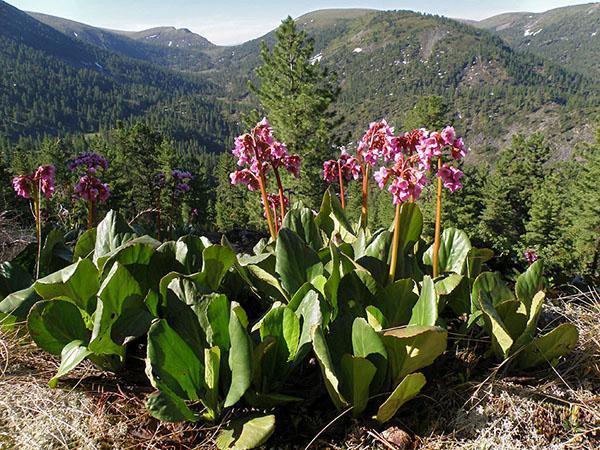Healer from Tibet - badan
 Badan also called Mongolian, Siberian and Chagir tea. How pleasant it is to drink a tart aromatic drink and at the same time understand how much benefit this herb brings to the body. Moreover, in recent years, it has begun to be widely used for decorative purposes. Now the flower has become both a wonderful garden decoration and a healing medicine.
Badan also called Mongolian, Siberian and Chagir tea. How pleasant it is to drink a tart aromatic drink and at the same time understand how much benefit this herb brings to the body. Moreover, in recent years, it has begun to be widely used for decorative purposes. Now the flower has become both a wonderful garden decoration and a healing medicine.
The perennial culture is very beautiful and at the same time extremely hardy. Glossy leaves look amazing in combination with dense inflorescences. Bell-shaped flowers are pink, purple and red.
More about benefits
Mountain slopes in Tibet, Mongolia, China, Afghanistan and Siberia are covered with this medicinal plant. For three centuries, residents of Asian countries have been using the leaves and roots of the flower in folk medicine. They contain much more tannins than oak bark. Complement them:
- mineral elements: copper, manganese and iron;
- vitamin C;
- glycosides, the concentration of which increases with drying of the greenery;
- organic acids;
- various resins and gums;
- essential oils;
- tannins;
- phytocydes.
Such a "set" of natural ingredients does wonders for diseases of the intestinal tract. Mongolian tea is recommended for those who suffer from dysentery or diarrhea. It is used to treat cystitis, uterine fibroids, rheumatism and colitis.
Moreover, badan is used as:
- an anesthetic for severe headaches;
- hemostatic therapy;
- wound healing mixtures;
- expectorant syrup (lung disease, bronchitis, etc.);
- anti-dandruff / seborrhea shampoos.
Lotions and compresses from the Chagir drink improve skin condition. They are recommended for dermatosis and other rashes on the body.
There are also contraindications to tea. Patients who have low blood pressure, constipation and tachycardia should avoid this kind of homeopathy.
Procurement of raw materials and tea recipe
Bergenia leaves are harvested (or roots are dug out) in late autumn. The foliage is looking for a brown, brown color. In addition, older specimens are chosen, since many useful substances have accumulated in them over the years. For those who did not have time to do the harvesting in the winter, you can try to do it in early spring, when the snow melts. Some people say that it is better for the plant if it overwinters. The roots must undergo special processing before packing. They should be:
- Rinse;
- cut along and then across;
- in the open air, hold for a couple of days that they become lethargic;
- then dry in drying at a temperature of 50-60 ° C;
- packaged in natural fabric bags;
- store no more than 4 years.
To prepare a medicinal drug that helps with dysentery, you need to brew 2 tbsp. l. dried roots in a glass of boiling water. Tea is not insisted, but immediately filtered. Take the medicine 1 tablespoon three times a day. As soon as the symptoms disappear, therapy is stopped. This is what a miraculous effect badan has - an amazing healer from Tibet.